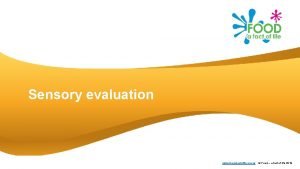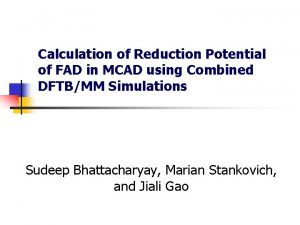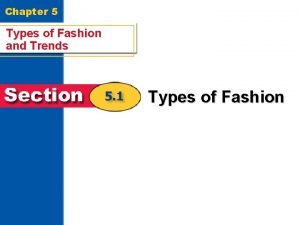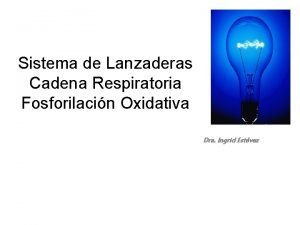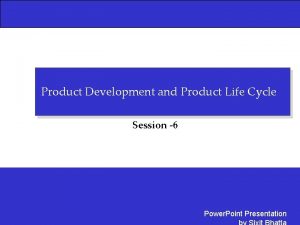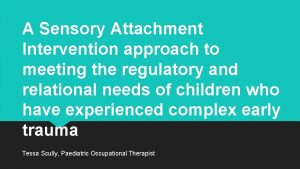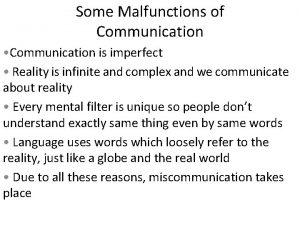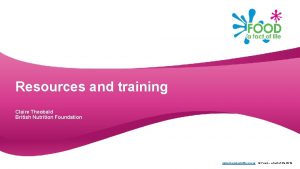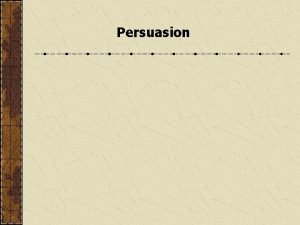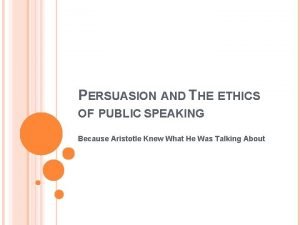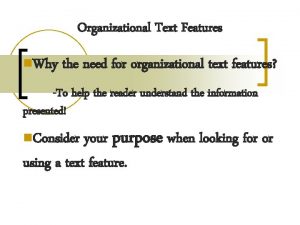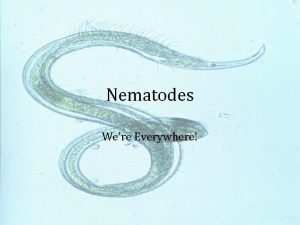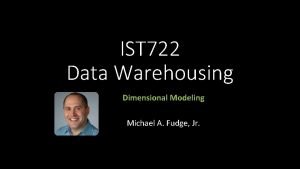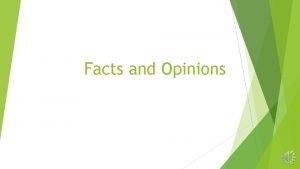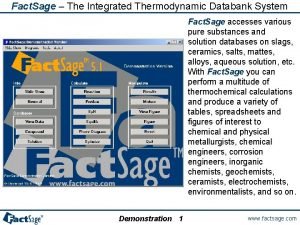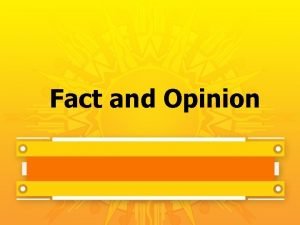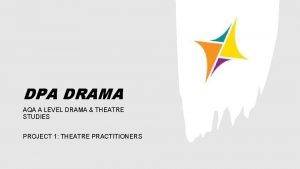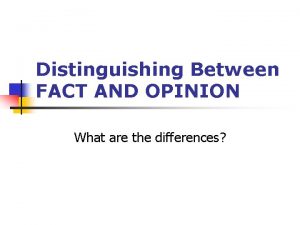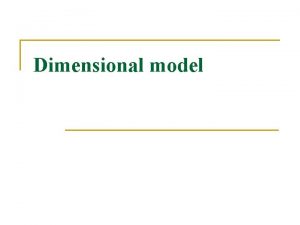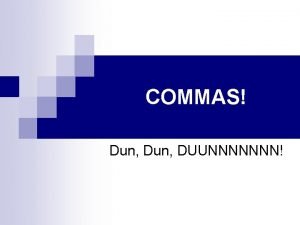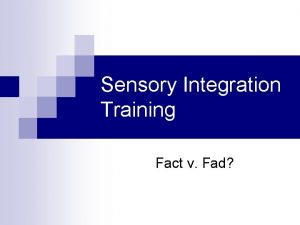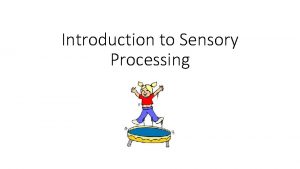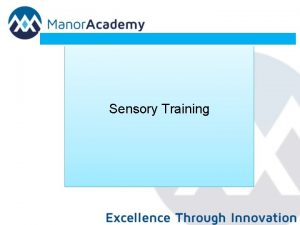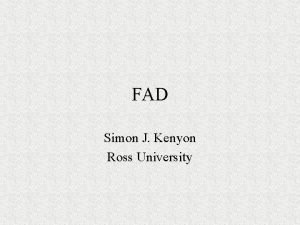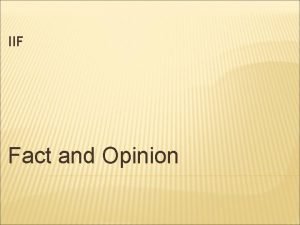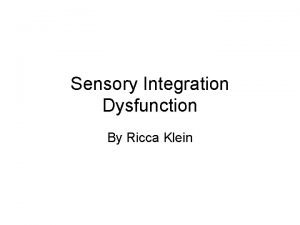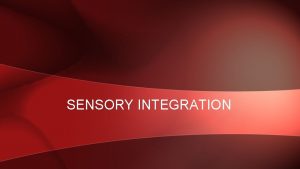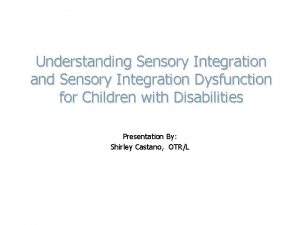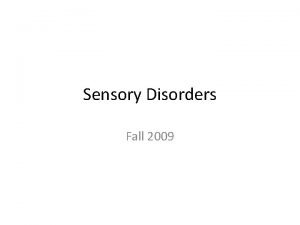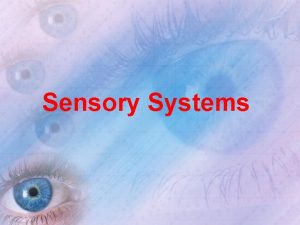Sensory Integration Training FACT OR FAD Sensory Integration



























































- Slides: 59

Sensory Integration Training FACT OR FAD?

Sensory Integration Dysfunction (SID) Children with SID frequently experience problems with their sense of touch, smell, hearing, taste and/or sight. Also often experienced difficulties in movement, coordination and sensing where one's body is in a given space. Common disorder for individuals with neurological conditions such as an autism spectrum disorder. Individuals may be overly sensitive to certain textures, sounds, smells and tastes, while wearing certain fabrics, tasting certain foods, or normal everyday sounds may cause discomfort. The opposite is also possible - for example a child with an autism spectrum disorder may feel very little pain or actually enjoy sensations that neurotypical children would dislike: strong smells, intense cold or unpleasant tastes.

Sensory Integration Therapy w/ Children Occupational therapy with child placed in a room specifically designed to stimulate and challenge all of the senses. During the session, therapist works closely with the child to encourage movement within the room. The therapy is driven by four main principles: 1) 2) 3) 4) the child must be able to meet the challenges through playful activities the child adapts behavior to meet the challenges presented the child will want to participate because the activities are fun the child's preferred activities are used in the session Careful to not provide children w/ more sensory stimulation than they can cope with. The occupational therapist looks for signs of distress.

Examples of Sensory Integration Treatments Prism lenses Physical exercise Auditory integration training Sensory stimulation or inhibition techniques such as "deep pressure"—firm touch pressure applied either manually or via an apparatus such as a hug machine or a pressure garment. Weighted vests, a popular deep-pressure therapy, have only a limited amount of scientific research available, which on balance indicates that therapy is ineffective.

Examples: Sensory Integration Therapy Sense of touch varies widely between children experiencing SID. When children enjoy the feel of sticky textures, therapist may use materials such as glue, play dough, stickers, rubber toys and sticky tape. Other materials that can be useful for tactile sensation include water, rice, beans and sand. Children on the autism spectrum often enjoy a sense of firm overall pressure. Interventions =wrapping them up in blankets, being squashed by pillows and firm hugs. Experiences that may be claustrophobic for neurotypical children may be enjoyed, such as being squashed between mattresses, and making tunnels or tents from blankets over furniture.

Common Examples in Schools Sensory Rooms Some pictures of sensory rooms http: //teachinglearnerswithmultipleneeds. blogspot. com/ 2008/02/sensory-rooms-on-cheap-revisited. html Aka -- Snoezelen Rooms Occupational Therapists usually suggest practices

What does the Research Say?

Sensory Integration Training (SIT) Leong & Carter (2008) Review of the Research on SIT Examined past key reviews of SIT intervention studies through 1994 Then examined SIT intervention studies from 19942007 Findings Consistent w/ numerous previous reviews, no robust evidence supporting the efficacy of SIT was found In light of the accumulated lack of evidence for the effectiveness of SIT, continued use of the techniques outside of research contexts does not appear to be justified

SIT Research Summary SIT is used widely across groups including: Learning disabilities Intellectual disabilities Autism Spectrum Disorders Though research dates back 40 years, SIT has yet to be proven effective for any of these groups

School-wide Systems RTI & PBIS Critical Foundations for Inclusive Education

Inclusion Starts with Effective Host Environments n n Foundation of Research-Based Practices School-wide Intervention models ¨ RTI & SW-PBIS ¨ Effective Behavior Management n Clear behavioral expectations & routines n Acknowledgment of desired behavior ¨ Effective Instruction ¨ Data Based Decision Making n Universal Screening & Progress Monitoring

Critical Concepts of SPED

Academic-Behavior Message STUDENT ACHIEVEMENT Good Teaching Behavior Management Increasing District & State Competency and Capacity Investing in Outcomes, Data, Practices, and Systems

Response to Intervention Social Sciences Specials SWPBS Etc. Literacy & Writing Numeracy & Sciences

“Response-to-Intervention” IMPLEMENTATION W/ FIDELITY CONTINUUM OF UNIVERSAL EVIDENCE-BASED SCREENING INTERVENTIONS DATA-BASED PREVENTION DECISION MAKING & EARLY & PROBLEM INTERVENTION SOLVING CONTINUOUS PROGRESS MONITORING

ESTABLISHING CONTINUUM of SUPPORTS ~5% ~15% TERTIARY PREVENTION • Function-based support • Wraparound • Person-centered planning • • SECONDARY PREVENTION • Check in/out • Targeted social skills instruction • Peer-based supports • Social skills club • ~80% of Students PRIMARY PREVENTION • Teach SW expectations • Proactive SW discipline • Positive reinforcement • Effective instruction • Parent engagement •

Response to Intervention Academic Systems Intensive, Individual Interventions • Individual Students • Assessment-based • High Intensity Targeted Group Interventions • Some students (at-risk) • High efficiency • Rapid response Universal Interventions • All students • Preventive, proactive Circa 1996 80 -90% Behavioral Systems 1 -5% 5 -10% Intensive, Individual Interventions • Individual Students • Assessment-based • Intense, durable procedures Targeted Group Interventions • Some students (at-risk) • High efficiency • Rapid response 80 -90% Universal Interventions • All settings, all students • Preventive, proactive

Overview of SWPBS

School-wide Positive Behavior Support is: n A systems approach for establishing the social culture and individualized behavioral supports needed for schools to be effective learning environments for all students. n Evidence-based features of SW-PBS n n n n Prevention Define and teach positive social expectations Acknowledge positive behavior Arrange consistent consequences for problem behavior On-going collection and use of data for decision-making Continuum of intensive, individual interventions. Administrative leadership – Team-based implementation (Systems that support effective practices)

EM S TA ST Not new…its specific practice based on or Not limited to any curriculum…it’s long history of a particular group of behavioral general approach practices & students…it’s effective to preventing instructional for all students design problem & strategies behavior DA Supporting Staff Behavior OUTCOMES SY Elements of SWPBIS Supporting Social Competence & Academic Achievement PRACTICES Supporting Student Behavior Supporting Decision Making

BIG IDEA Successful individual student behavior support is linked to host environments or school climates that are positive, predictable, effective and efficient. (Zins & Ponti, 1990)


Classroom Setting Systems m o o ms r s te s a s l y c n g. S o N ttin Se School-wide Positive Behavior Support Systems Ind ivi du Sy al S ste tu ms den School-wide Systems t

Why SWPBS? What does the data say?

Cost Benefit Analysis Reactive Discipline v. PBS Oregon Middle School Example 5100 referrals = 76, 500 min. @ 15 min. /referral = 1275 hrs. = 159 days @ 8 hrs/day almost an entire school year n Principal was at work 16 hr. /day and it didn’t help n Implemented PBS and referrals were reduced by over half in first year

Universal Systems Primary Interventions SW-PBIS

Teach, precorrect, supervise, & reinforce expected behavior & routines Accurate & fluent implementation Screener for nonresponders Prevention for 80% Adapted from Sugai, 2009 Consistent Consequences School. Wide PBS Team Active administrator participation (Primary Tier) Integrated continuum of evidence-based behavior support

Getting Started at your School

Team-led Process Family Priority & Status Specialized Support Data-based Decision Making Student Non-Teaching Behavioral Capacity Representation Administrator Team Community Administrator Communications Teaching Start with Team that “Works. ”

Team GENERAL IMPLEMENTATION PROCESS Agreements • Readiness agreements, prioritization, & investments • 3 -4 year implementation commitment Data-based Action Plan • Local capacity for training, coordination, coaching, & evaluation • Systems for implementation integrity Evaluation Implementation

Team Process: Buy-in & Support n Make PBS visible thru frequent updates and communication w/ staff ¨ Build a PBS minute into all staff meetings ¨ Post progress on PBS programs & data on a PBS Bulletin Board in the staff room ¨ No surprises, process is important n Seek feedback from all staff ¨ Before staff finalizing decisions, get feedback from

Establishing a Social Culture Common Language MEMBERSHIP Common Experience Common Vision/Values

School-wide Rules: Creating a Culture Chris Borgmeier, Ph. D Portland State University cborgmei@pdx. edu (503) 725 -5469

Guidelines for Developing School-wide Rules n n 3 -5 Positively Stated Rules should be: ¨ Broad enough to cover all potential behavior ¨ Stated positively ¨ Brief and easy to remember ¨ Catchy – personalized to your school n Common Examples ¨ Be Safe, Be Responsible, Be Respectful

Why 3 -5 Positively Stated Rules? They are easier to Learn & Remember Increased Generalization of Rules: Same rules can be used across staff & settings

Few positive SW expectations defined, taught, & encouraged

Teaching Matrix Expectations Respect Ourselves SETTING All Settings Be on task. Give your best effort. Be prepared. 1. Respect Others Respect Property Be kind. Hands/feet to self. Help/share with others. Recycle. Clean up after self. Hallways Playgrounds Use normal voice volume. Walk to right. L L I K S L Assembly Bus Sit in one spot. Watch for your stop. Have a plan. Study, read, compute. Play safe. Include others. Share equipment. Practice good table manners Whisper. Return books. Listen/watch. Use appropriate applause. Use a quiet voice. Stay in your seat. Push in chairs. Treat books carefully. Pick up. Treat chairs appropriately. Wipe your feet. Sit appropriately. R O I V A S H E E L B P. M 3 A EX Pick up litter. Maintain physical space. 2. NA CO T NT UR EX AL T Eat all your food. Select healthy foods. A I C O S Walk. Cafeteria Library/ Computer Lab Use equipment properly. Put litter in garbage can. Replace trays & utensils. Clean up eating area.

Expectations & behavioral skills are taught & recognized in natural context

Acknowledgement Systems: Catch ‘em being Good

Acknowledge & Recognize

Acknowledgment Systems n Purpose: ¨ To reinforce school rules, behavioral expectations & positive behavior ¨ Promote a more positive school environment n School-wide 5: 1 positive/negative interaction ratio n Regular school-wide celebration of positive behavior ¨ Increase v Prompt positive interactions b/w staff & students busy adults to remember to reinforce positive behavior

5: 1 ratio, it’s not just for kids n Business teams ¨ High Performance teams = 5. 6 to 1 ¨ Medium Performance teams = 1. 9: 1 ¨ Low Performance teams = 1 to 2. 7 n n Losada, 1999; Losada & Heaphy 2004 Married couples that last ¨ 5. 1 to for speech acts and 4. 7 to 1 for observed emotions n Gottman, 1994


Train staff how to hand out Acknowledgments n “Sergio, thank you for picking up Jackie’s book for her you are being very Respectful. I want to recognize your good behavior with a Caught Being Good ticket, I really appreciate it when you follow the school rules. ” 1) 2) 3) Always pair the ticket with a verbal explanation that is genuine, clear & specifically identifies the behavior Link with school rule It is best to provide the ticket immediately after the student engages in the behavior

Data Based Decision Making

Data Systems – CRITICAL! n Student Data System ¨ www. swis. org ¨ SWIS n Facilitator Trainings Essential features of a Data Systems ¨ Capacity for SW & Indiv Student Decision Making ¨ Easy data entry ¨ Easy data summary & recall ¨ Capacity to easily ‘mine’ the data to answer questions ¨ Graphic display for easier data analysis & decision making

Version 3. 1. 5 stable Main Menu User: Chavez School: Cesar Chavez Academy SWIS Copyright (c)2003 May, Ard, Todd, Horner, Glasgow, Sugai, & Sprague

Average Referrals per Day per Month Middle School of 600 students

Referrals by Location

Referrals by Time

Referrals by Student

District Supports & Planning

Premise of SW-PBS n The ability of schools to sustain effective and accurate implementation of SW-PBS is largely dependent upon the school district and local/regional supports that are in place. (extend this logic beyond SW-PBS to any effort to implement evidence-based practices)

Why a SYSTEMS Approach to SW-PBS? Moving Beyond “Train & Hope” TRAIN & HOPE / EXPERT MODEL 1) Difficult-to-solve problem is encountered. 2) Expert is identified to provide a solution. 3) Expert provides or trains the solution. 4) Expert leaves and expects school to implement the solution. 5) Lacking supports and capacity, solution is not implemented effectively. 6) School waits for next problem to occur (“expert model” reinforced). Baer & Stokes, 1977

Overview of PBS Organization Logic PBS Coach


Student Outcome Measures ¨ Office Discipline Referrals (ODRs) ¨ Suspension/Expulsion ¨ LRE data ¨ School climate Surveys (staff, student) ¨ Attendance ¨ Academic Achievement data State test scores n DIBELs n ¨ etc.


 Food fact of life sensory evaluation
Food fact of life sensory evaluation Why should teen athletes avoid performance enhancers?
Why should teen athletes avoid performance enhancers? Alessandro cembran
Alessandro cembran Fad.curi.ucad.sn
Fad.curi.ucad.sn Trend vs fad
Trend vs fad Lanzaderas malato aspartato y glicerol 3 fosfato
Lanzaderas malato aspartato y glicerol 3 fosfato Fadlife
Fadlife Which segment of society introduced the grunge look?
Which segment of society introduced the grunge look? Fad diets def
Fad diets def Axon
Axon Just right state programme
Just right state programme Three dimensions of corporate strategy
Three dimensions of corporate strategy Forward integration and backward integration
Forward integration and backward integration Simultaneous integration example
Simultaneous integration example Integration
Integration Training is expensive without training it is more expensive
Training is expensive without training it is more expensive Metode of the job training
Metode of the job training Aggression replacement training facilitator training
Aggression replacement training facilitator training Site:slidetodoc.com
Site:slidetodoc.com What is a fact file
What is a fact file In fact commas
In fact commas Viewing television is a wasteful activity claim of fact
Viewing television is a wasteful activity claim of fact Sun fact sheet
Sun fact sheet Sun fact sheet
Sun fact sheet Thanksgiving facts
Thanksgiving facts Which of the following is not a fact finding technique
Which of the following is not a fact finding technique Sun fact file
Sun fact file Fact-inference confusion examples
Fact-inference confusion examples Examples of sociology
Examples of sociology Igneous rock identification lab
Igneous rock identification lab Explore food.foodafactoflife
Explore food.foodafactoflife Proposition of fact examples
Proposition of fact examples Claim of fact value and policy examples
Claim of fact value and policy examples External text features
External text features Organelle fun facts
Organelle fun facts Interesting facts about nematoda
Interesting facts about nematoda Nanotechnology fact or myth articles
Nanotechnology fact or myth articles Social fact examples
Social fact examples Hasty conclusion
Hasty conclusion Types of fact tables
Types of fact tables Proposition of fact examples
Proposition of fact examples Opinion about my family
Opinion about my family Argumentum ad speculum
Argumentum ad speculum Fact and opinion about pizza
Fact and opinion about pizza Explain the fact-finding techniques
Explain the fact-finding techniques Fact sage
Fact sage Fact or bluff about science
Fact or bluff about science Article with fact and opinion
Article with fact and opinion Fact or opinion jeopardy
Fact or opinion jeopardy Example of facts and opinion
Example of facts and opinion Opinion examples
Opinion examples Physical change fact
Physical change fact English claims
English claims Aqa a level drama
Aqa a level drama Fact statements examples
Fact statements examples Degenerate dimension
Degenerate dimension How to populate fact table sql server
How to populate fact table sql server Food a fact of life costing
Food a fact of life costing Spectre marketing
Spectre marketing Commas to separate adjectives
Commas to separate adjectives
